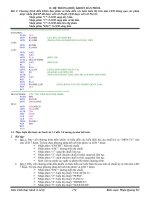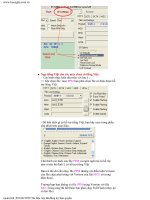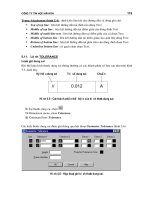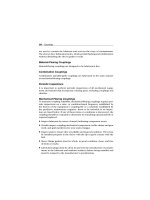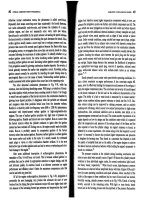Seamanship Techniques 2 Episode 1 pptx
Bạn đang xem bản rút gọn của tài liệu. Xem và tải ngay bản đầy đủ của tài liệu tại đây (1.63 MB, 30 trang )
SEAMANSHIP TECHNIQUES
2nd edition
By the same author
Navigation for Masters ISBN 185609 147 3
Marine Survival and Rescue Systems ISBN 185609 1279
An Introduction to Helicopter Operations at Sea ISBN 185609 1686
Cargo Work (Kemp & Young) Revised ISBN 07506 3988 1
Seamanship Techniques (The Command Companion) Vol. III ISBN 07506 4443 5
Anchor Practice: A Guide for Industry ISBN 185609 2127
SEAMANSHIP
TECHNIQUES
SECOND EDITION
PART ONE: SHIPBOARD PRACTICE
PART TWO: SHIP HANDLING
D. J. HOUSE
Oxford Auckland Boston Johannesburg Melbourne New Delhi
Butterworth-Heinemann
Linacre House, Jordan Hill, Oxford OX2 8DP
225 Wildwood Avenue, Woburn, MA 01801-2041
A division of Reed Educational and Professional Publishing Ltd
A member of the Reed Elsevier plc group
First published as two volumes 1987
Volume 1 first published as paperback 1989
Volume 2 first published as paperback 1990
Single volume edition 1994
Reprinted 1995, 1997, 1998, 1999 (twice)
Second edition 2001
© D. J. House 1987, 1994, 2001
All rights reserved. No part of this publication
may be reproduced in any material form (including
photocopying or storing in any medium by electronic
means and whether or not transiently or incidentally
to some other use of this publication) without the
written permission of the copyright holder except in
accordance with the provisions of the Copyright,
Designs and Patents Act 1988 or under the terms of a
licence issued by the Copyright Licensing Agency Ltd,
90 Tottenham Court Road, London, England W1P 0LP.
Application for the copyright holder’s written permission
to reproduce any part of this publication should be addressed
to the publishers
ISBN 0 7506 5231 4
British Library Cataloguing in Publication Data
House, D.J.
Seamanship techniques. – 2nd ed.
1. Seamanship
I. Title II. Shipboard practice III. Ship handling
623.8’8
Library of Congress Cataloguing in Publication Data
A catalogue record for this book is available from the Library of Congress
www.bh.com/engineering
Typeset in Replika Press Pvt Ltd. 100% EOU, Delhi 110 040
Printed and bound by Replika Press Pvt Ltd. 100% EOU, Delhi 110 040
ABS American Bureau of
Shipping
A.C. Alternating Current
AHV Anchor handling vessel
AIS Automatic Identification
System
AMVER Automated Mutual Vessel
Rescue system
ARCs Admiralty Raster Charts
ARPA Automatic Radar Plotting Aid
AUSREP Australian Ship Reporting
system
B.S. Breaking Strain
BV Bureau Veritas
CABA Compressed Air Breathing
Apparatus
CES Coast Earth Station
CG Coast Guard
CMS Constantly Manned Station
CO
2
Carbon Dioxide
C of B (B) Centre of Buoyancy
C of G (G) Centre of Gravity
CPA Closest Point of Approach
CPP Controllable Pitch Propeller
CQR Chatham Quick Release
CRS Coast Radio Station
CS Coast Station
DC Direct Current
DGPS Differential Global
Positioning System
DNV Det Norske Veritas
DRHQ Divisional Rescue Head
Quarters
DSC (i) Dynamically Supported Craft
(hydrofoils)
DSC (ii) Digital Selective Calling
DWT (DW) Deadweight
ECDIS Electronic Chart Display
Information System
EFSWR Extra Flexible Steel Wire
Rope
ENC Electronic Navigation Chart
EPIRB Emergency Position
Indicating Radio Beacon
ETA Estimated Time of Arrival
FRC Fast Rescue Craft
FSM Free Surface Movement
FSWR Flexible Steel Wire Rope
FWA Fresh Water Allowance
GHz gigahertz
GM Metacentric Height
GMDSS Global Maritime Distress and
Safety System
GMT Greenwich Mean Time
GPS Global Positioning System
GT (g.t.) Gross Tons
GZ Righting Lever
HF High Frequency
HLO Helicopter Landing officer
HMS Her Majesty’s Ship
HMSO Her Majesty’s Stationery Office
HRU Hydrostatic Release Unit
HSC High Speed Craft (code)
IAMSAR International Aeronautical
and Maritime Search and
Rescue Manual
ICAO International Civil Aviation
Authority
ABBREVIATIONS
(Marine abbreviations used in this text and within the marine industry)
ICS International Chamber of
Shipping
IHO International Hydrographic
Office
IMDG International Maritime
Dangerous Goods Code
IMO International Maritime
Organisation
ISM International Safety
Management
ITU International
Telecommunications Union
KB Measured distance between
the keel and the ships centre
of buoyancy
KG Measured distance between
the keel and the ships centre
of gravity
kg kilogram
kHz kilohertz
kJ kilo Joule
KM Measured distance between the
keel and the ships metacentre
kN kilo Newton
kW kilowatt
lbs pounds
LBP length between
perpendiculars
LCB Longitudinal Centre of
Buoyancy
LFL Lower Flammable Limit
LNG Liquid Natural Gas
LOA length over all
LR Lloyds Register
LUT Land User Terminal
MA Mechanical Advantage
MAIB Marine Accident
Investigation Branch
MARPOL Maritime Pollution
Convention
mbs millibars
MCA Maritime and Coastguard
Agency
MEC Marine Evacuation Chute
MES Marine Evacuation System
MGN Marine Guidance Notice
MHz megahertz
MIN Marine Information Notice
MN Mercantile Marine
MNTB Merchant Navy Training Board
MoB Man overboard
MPCU Marine Pollution Control Unit
MRCC Marine Rescue Co-ordination
Centre
MSI Marine Safety Information
MSN Merchant Shipping Notice
(previous ‘M’ notice)
NUC Not Under Command
NVE Night Vision Equipment
OiC Officer in Charge
OOW Officer of the Watch
OSC On Scene Co-ordinator
P/A Public Address System
RN Royal Navy
RNR Royal Naval Reserve
RoPax Roll on/Roll off + Passengers
RoT Rate of Turn
Ro-Ro Roll on, Roll off
rpm Revolutions per minute
R/T Radio Telephone
Rx Receive
SAR Search and Rescue
SARSAT Search and Rescue Satellite
SART Search and Rescue Radar
Transponder
SES Ship Earth Station
SOLAS Safety of Life at Sea
(convention)
SOPEP Ships Oil Pollution
Emergency Plan
SPM Single Point Mooring
STCW Standards of Training,
Certification and
Watchkeeping (convention)
SWL Safe Working Load
SWR Steel Wire Rope
T.D. Tonnage Deck
TMC Transmitting Magnetic
Compass
TRS Tropical Revolving Storm
UFL Upper Flammable Limit
UHF Ultra High Frequency
U.K. United Kingdom
UKC Under Keel Clearance
ULCC Ultra Large Crude Carrier
U.S. United States
USCG United States Coast Guard
VCG Vertical Centre of Gravity
VDR Voyage Data Recorder
VDU Visual Display Unit
VHF Very High Frequency
VLCC Very Large Crude Carrier
VTMS Vessel Traffic Management
System
VTS Vessel Traffic System
W/L Waterline
WNA Winter North Atlantic
Wps wires per strand
W/T Wireless Telegraphy
vi Abbreviations
PART ONE
SHIPBOARD PRACTICE
CONTENTS TO PART ONE
Abbreviations v
Preface xiii
Acknowledgments xiv
List of plates xv
List of tables xvii
1. THE SHIP
Introduction 1
Terms and definitions 1
Terms and definitions concerning stability 5
Varieties of ship 6
Plate and construction terms 6
Main structural members – compensating stress factors
affecting vessel 19
Stresses in ship structures 20
Loadlines 22
2. ANCHOR WORK
Anchors 25
Tests on anchors 27
Marks on anchors 29
Anchor certificate 29
Chain cable tests 29
Notes on cable 30
Kenter lugless joining shackle 30
‘D’ lugged joining shackle 32
Securing and stowage of anchors 33
Securing anchor and cable 33
Steam windlass operation 34
Preparing anchor for ‘letting go’ 34
Cable holders 35
Procedure for coming to anchor 36
Clearing away anchors 40
Anchor terminology 41
Watch at anchor 46
Deep water anchoring 49
Laying/carrying out anchors 49
Clearing a foul hawse 50
To weigh anchor by deck tackle 52
Anchor recovery – loss of windlass power 52
Hanging off an anchor 53
Lost anchor and re-securing of spare anchor 55
Mooring anchors 57
3. ROPEWORK
Natural fibre ropes 59
Lay of rope 62
Small stuff 63
Synthetic fibre ropes 65
Bends and hitches 67
Working aloft and overside 71
Seizings 73
Ropework and cordage tools 74
Worming, parcelling and serving 75
Cordage splice 76
Whippings 77
Marrying two ropes together 78
To pass a stopper 79
Breaking out mooring rope 81
4. WIREWORK AND RIGGING
Steel wire rope 82
Steel wire rope rigging 86
Rigging fitments 91
Wire splicing 93
Stowage of wire hawsers 96
Safe handling procedures for wire rope 96
Mousing a hook or shackle pin 97
Blocks – care and maintenance 98
Blocks and tackles 100
5. LIFTING GEAR
Derricks 106
Union purchase 110
Safe handling practice for derricks 112
Doubling-up procedure 113
Butterfly rig 113
Yo-Yo rig 114
Hallen universal derrick 115
Hallen container derrick 116
x Contents to Part One
Velle shipshape crane 117
Heavy lift procedures 118
Cranes 121
Cranes and derricks – advantages and disadvantages 124
Derrick tests and surveys 125
Rigging of sheer legs 125
Rigging of gyn 127
Hand signals 127
Calculating stresses in derricks by empirical formula 127
6. CARGO AND HATCHWORK
Conventional hatch 142
Conventional hold 145
Steel hatch cover 146
General cargo terminology 152
Duties of junior cargo officer 153
Hold preparation 154
Stowage methods 155
Cargo handling 156
Ventilation 158
Refrigerated cargoes 158
Carriage of goods in deep tanks 160
Container tonnage 162
Roll on–roll off system 162
Cargo plans 164
7. BOATWORK
Parts of the lifeboat 168
Types of wood construction 171
Boat fitments 172
Totally enclosed survival craft 180
Partially enclosed boats 186
Boat rigging 188
Launching procedure 191
Taking boat away from ship’s side 196
Boat recovery in heavy weather 197
Beaching lifeboat 198
Boat handling and safe procedures 200
Markings on sails 201
Sail theory 201
Sail terminology 203
8. SURVIVAL CRAFT AND PRACTICE
Survival systems international 204
The Inflatable life raft 204
Launching inflatable life raft 211
Boarding raft 212
Rigid life rafts 212
xiContents to Part One
xii Contents to Part One
The davit launched life raft 214
Additional fitments to raft 221
Abandoning ship 222
Marine evacuation system 225
Evacuation-slide launching and embarkation 225
Righting capsized life raft 227
Beaching a life raft 227
9. COMMUNICATIONS
Methods employed in marine industry 245
Flag signalling terms 249
Single letter meanings – International Code of Signals 250
Signalling by International Code flags 250
Important two-letter signals 255
Sample messages employing International Code of Signals 256
Flag maintenance 256
Wearing of ensigns 257
Morse code procedure – signalling by flashlight 260
Morse code regular procedural signals 262
Morse code signalling by hand flags or arms 262
APPENDIX:
Seaman’s self-examiner 264
Efficient deck hand examination 264
Certificate of Proficiency in Survival
Craft and Rescue Boats 266
32. Rack stowage of inflatable life rafts 210
33. Davit launched life raft 214
34. Inflatable life raft 219
35. Training with helicopter strop 235
36. Semi-rigid inflatable 240
xvi Plates to Part One
2 Seamanship Techniques
Abeam
Port quarter
Right astern
Starboard quarter
Abeam
Starboard bow
Right ahead
Ship’s beam
Port bow
Figure 1.1 The ship in relation to its surroundings.
Ahead
‘Right ahead’ is the line the fore and aft line, if projected, would extend
in front of the vessel (Figure 1.1). Opposite to the term ‘astern’, when
used in relation to relative bearings. It may also be used as an engine-
room order to cause the engines to turn in order to move the ship ahead.
Amidships
The middle of the vessel in both transverse and longitudinal directions.
More commonly used as a helm order, when it is usually shortened to
‘midships’ (see ‘Chapter 1’, Pa r t Two).
Athwartships
Defined as ‘in a direction’ from one side of the ship to the other, at right-
angles to the fore and aft line.
Breadth
The maximum beam of the vessel measured from the outside edge of the
shell plating on either side of the vessel is the extreme breadth (Figure 1.2).
The beam of the vessel measured amidships, between the inside edge
of the shell plating on either side of the vessel, is the moulded breadth
(Figure 1.2).
Camber (or round of beam)
The curvature of the deck in the athwartships direction. The measure-
ment is made by comparing height of deck at the centre of the vessel to
height of deck at the side of the vessel (Figure 1.2).
Depth
The extreme depth of the vessel is measured from the bottom side of the
keel to the top of the deck beams, the measurement being taken at the
side of the vessel.
The moulded depth is measured from the top side of the keel to the
top of the deck beams, at the side of the vessel.
3The Ship
Camber
Rise of floor
Summer load line
Flare
The outward curvature of the shell plating in the foremost part of the
vessel, providing more width to the fo’c’sle head and at the same time
helping to prevent water coming aboard.
Fore and Aft Line
An imaginary line passing from the stem to the stern through the centre
of the vessel (Figure 1.3).
Freeboard
This is the vertical distance, measured at the ship’s side, from the waterline
to the top of the freeboard deck edge. The freeboard measurement
is taken at the midships point. Deck edge is marked by a painted line
25 mm × 100 mm.
Keel Rake
The inclination of the line of the keel to the horizontal (Figure 1.4).
Tumblehome
Depth
Water line
Freeboard
Draught
Moulded breadth
Base line
Aft
sheer
For’d
sheer
B
Figure 1.2 Ship’s principal dimensions.
Keel
Extreme breadth
Length overall (LOA)
Length on the waterline (LWL)
Length between perpendiculars (LBP)
4 Seamanship Techniques
Length between Perpendiculars (LBP)
The distance between the for’d and aft perpendiculars.
Length Overall (LOA)
The maximum length of the vessel measured from the extreme for’d
point of the vessel to the extreme after point (Figure 1.2).
Perpendiculars
A perpendicular drawn to the waterline from a point on the summer load-
line where it intersects the stempost is called the forward perpendicular (FP).
A perpendicular drawn to the waterline at a point where the after
side of the rudder post meets the summer waterline is called the aft
perpendicular (AP). If a rudder post is not fitted, then it is drawn from
the centre of the rudder stock.
Rise of Floor
This is the rise of the bottom shell plating above the base line (taken
from the top edge of the keel).
Sheer
This is the curvature of the deck in the fore and aft direction, measured
as the height of the deck at various points above the height of the deck
at the midships point (Figure 1.2).
Ship’s Beam
The widest part of the ship in the transverse athwartships direction
(Figure 1.1).
Stem Rake
The inclination of the stem line to the vertical.
FOR’DMidshipsAFT
Fore and
aft line
After
deck
All aft
accommod’n
block
Maindeck
or Foredeck
Navigation bridge
Accom.
Uppermost Continuous Deck
Mach’y
space
E/R
Steering flat
After peak
ballast tank
T/D
’Tween deck
Lower hold or tank area
Forepart
Bulbous
bow
Collision bulkhead
Double bottom tanks
Figure 1.3 The ship in section and plan.
Figure 1.4 Keel rake.
Figure 1.5 Coefficient of fineness.
X
W
Z
Y
C=
Area of water plane
Area of rectangle WXYZ
W
Fo’c’sle
head
7The Ship
G
E
J
O
E
A
C
D
No. 5 Hold
15
PQ
B
Engine room
Engine room
45 80 130105 155 190
φ
No. 4 Hold
No. 3 Hold
No. 2 Hold
H
I
K
M
X
W
R
U
T
V
S
020
SCALE (metres)
Figure 1.9 Longitudinal profile plan of general cargo
vessel.
A Steering gear flat
B Aft peak
C Upper ’tween deck
D Poop ’tween deck
E No. 5 double bottom tanks
F Oil fuel tanks
G Engine room double bottom tanks
H Upper ’tween deck
I Lower ’tween deck
J No. 4 double bottom tanks
K, L Upper ’tween deck
M, N Lower ’tween deck
O No. 3 double bottom tanks
P No. 2 double bottom tanks
Q No. 1 double bottom tanks
R No. 2 cargo tank
S Ballast tank
T Forepeak
U Store
V Chain locker
W No. 1 cargo tank
X No. 1 upper ’tween deck
Y No. 2 fo’c’sle ’tween deck
Z No. 1 fo’c’sle ’tween deck
Figure 1.10 Typical hold bilge pumping system.
KEY
Strum box (bilge)
Strum box/bi-directional
valves (double bottom)
Pipeline
Mud box
Valve chest – non-
return valves
Port bilge system
Double bottom system
Starboard bilge system
Engine room
F
Z
Y
L
N
8 Seamanship Techniques
Figure 1.11 Profile and general arrangement plans of
passenger/car ferry Kronprinsessan Victoria
(15,000 gross tons).
Figure 1.12 Kronprinsessan Victoria in section.
Length overall 150 m.
Moulded breadth 26 m.
Draught 6 m.
Deadweight (at design draught) 3100 tonnes.
Passenger complement 2100.
Trailer capacity 70 × 18 m.
Car capacity 700 × 4.5 m.
Baby care room
Dance
floor
Saloon Scullery
Ladies
Main entrance hall
Bank
Engine casing
Store
Office
Scullery
Office
Shopping
centre
Shopping arcade
Bar
Pantry
Gents
Luggage P&S
Information
Gents
Ladies
Deck 7
Deck 5
CHG
LKR
CHG
LKR
Store
Car DK
vent
Handicapped cabin P&S
Cafeteria
Hall
Shop store
Lashing gear
Ramp
Hydraul
room
Ramp
Car DK
vent
Store
STR
Lashing gear
Store
Lift No.1
Lift No. 4
Lift
No.2
Lift
No.3
STR
Engine casing
STR
Bar
STR
Lift No. 5
Ramp
Car deck
vent
Store
Car deck
vent
Store
Lift No. 6
Cafeteria & conference
Linen
222222222222
2
2
2
2
2
2
2
2
2
2
2
2
2
2
2
2
2
2
2
2
2
2
2
2
2
2
2
2
2
2
2
2
2
2
2
2
2
2
2
2
2
2
2
2
2
2
2
2
2
2
2
2
2
2
2
2
2
2
2
2
2
4
2
4
4
4
222222222
2
222
STR
Store
9The Ship
Figure 1.13 Profile and deck plans of 8030 tonne DW
products tanker Cableman.
XXXZPXXPX ZZ Z
XXXXXXX X
XXXXXXX X
XXXZPXXPX ZZ Z
S
S
Figure 1.14 Product carrier (tanker). Six tanks have heating
coils, and there are four main pump rooms,
with a capacity of 200 tons of water per
hour. For the stainless steel tanks, centrifugal
pumps can supply 30 tons per hour.
Tank coatings
P Polyurethane
S Stainless steel
X Epoxy coated
Z Zinc silicate
Boiler FW
feed tank
Domestic
FW TK
Fuel oil bunker
Main
engine
Aux set
Pump
room
PMP
No. 5 cargo tank
No. 1 cargo tank
No. 2 cargo tankNo. 3 cargo tankNo. 4 cargo tank
Deep
tank
WB
Bow
thrust
compt
Fore
peak
WB
FO TK
STR
gear
CO
2
RM
Engs
store
AC
room
Cold STR
Crews
mess
Galley
Officers
mess
Foam
room
Boiler
room
flat
Gas oil
tank
Pump
room
Ent
Hydro
pump
room
Store
Main
deck
AFT
peak
WB TK
Main
engine
Lower engine RM
Pump
room
Slop
tank
No. 5 cargo tank port
No. 5 cargo tank centre
No. 5 cargo tank STBD
No. 4 cargo tank port
No. 4 cargo tank centre
No. 4 cargo tank STBD
No. 3 cargo tank port
No. 3 cargo tank centre
No. 3 cargo tank STBD
No. 2 cargo tank port
No. 2 cargo tank centre
No. 2 cargo tank STBD
No. 1 cargo tank port
No. 1 cargo tank centre
No. 1 cargo tank STBD
Deep TK
WB
Fore peak
WB TK
Below main deck
AP WB
TK
10 Seamanship Techniques
2. The modern tanker, though small by today’s
supertanker size.
NB. New tankers are now required to be built with
double bottoms/double hulls to satisfy regulations.
1. The Roll On–Roll Off ferry. There is limited
passenger/driver accommodation on three vehicle
decks loaded from a stern door/ramp. An internal
ramp runs to upper deck level and a hydraulic lift to
lower hold. Trailer capacity is approximately one
hundred 40-ft units.
11The Ship
3. Modern high speed passenger ferry engaged on the Irish sea trade.
Figure 1.15 Chemical carrier.
12 Seamanship Techniques
Figure 1.16 Lok Priti (bulk carrier).
Length, oa 172.02 m
Length, bp 162.40 m
Breadth, moulded 22.80 m
Depth, moulded 14.70 m
Draught, moulded 10.88 m
Gross register 15 638 grt
Net register 10 502 nrt
Deadweight, total at 10.67 m draught 26 000 dwt
Deadweight, total at 10.88 m draught 27 000 dwt
Capacities:
Holds, including wing tanks and hatches 35 091 m
3
Ballast, including No. 4 hold 11 330 m
3
Heavy fuel 1530 m
3
Diesel fuel 94 m
3
Lube oil 135 m
3
Fresh water 208 m
3
Main engine GRSE-MAN-B&W K6Z78.155E
Output, mcr (7833 kW) 10 500 bhp at 122 rev/min
Trial speed, 87.5% mcr
(9 188 bhp) at loaded draught 15.00 knots
Endurance 12 000 nautical miles
COMPLEMENT
14 officers 2 cadets
8 petty officers 1 pilot
36 crewmen 1 owner
Total = 62
Figure 1.17 Refrigerated cargo lines (reefer) – early design (top) and modern design (below).
Profile of tramp reefer built in 1941 (
above
) and in 1978 (
below
)
5T
IOT
IOT
IOT
IOT
WB or Cargo WB or Cargo WB or Cargo WB or Cargo WB or Cargo WB or Cargo WB or Cargo
CHN
LKR
Fore
peak
WB
Hold No 1
pump room
WBWBWBWBWBWBWB
AP TK
Engine Room
Hold No. 7 Hold No. 2Hold No. 3Hold No. 4Hold No. 5Hold No. 6
CH Room
Sea Men
Store
Incinerator
Rope
store
Pro RM
Meat
RM
Veg
RM
Fish
CO
2
RM WC
Engine
casing
L’ndry
Toilet
Stores
Sea men
Hatch
No. 7
Hatch
No. 6
Hatch
No. 5
Hatch
No. 4
Hatch
No. 3
Hatch
No. 1
Hatch
No. 2
Store
Store
Hydraulic
pump
Rope
store
Paint room
Main deck
Water
ballast
WB
WB
WB
WB
WB
WB
WB
WB
WB
WB
FO
FO
FO
FO
Double bottom
13The Ship
Length oa 94.04 m
Length bp 80.00 m
Breadth moulded 18.00 m
Summer draught 4.55 m
Complement 22
Vehicle stern ramp.
2 fixed deck cranes, 25 tonnes.
Figure 1.18 Profile and upper deck plan of CCN-Maua’s 3450 DWT container RoRo/LoLo ship design.
Figure 1.19 Seabex One – profile,
maindeck and tank top
plans of offshore
support vessel
W. Ballast
tank
Engine-room
W. ballast tank
W. ballast tank
W. ballast tank
Fuel oil tank
Fuel oil tank
W. ballast
tank
W. ballast tank
Empty
Fresh
water
tank
Empty
Fore W.B
peak tank
Upper deck
Seabex One
Ballast water
AP
Fresh water
Stabiliser tank
Diesel oil
Moon-pool
Engine rooms
DP prop-rooms
FP
Main deck
FP
Tank top
FP
Moon-pool
AP
Ballast
Ballast
Ballast
Stabiliser tank
Stabiliser tank
Heavy oil
Moon-pool
Heavy oil
AP
Engine rooms
DP prop-rooms
14 Seamanship Techniques
Figure 1.20 Engine-room layout and disposition of
equipment on 13,230 DW container ship
Nathalie Delmas.
43
47
45
1
3750 307
41
2
3
49
44
25
26
48
56
55
53
54
15 18 21 24 27 29 31 34 37 40 43 45 48 51 54
40
39
38
37
50
46
36
35
42
33
34
44
32
31
1
29
28
27
25
51
52
21
22
23
24
41
4
5
6
7
8
9
10
11
12
13
14
15
3
2
1
F
F
3
2
17
16
30
26
19
18
16
17
58
20



